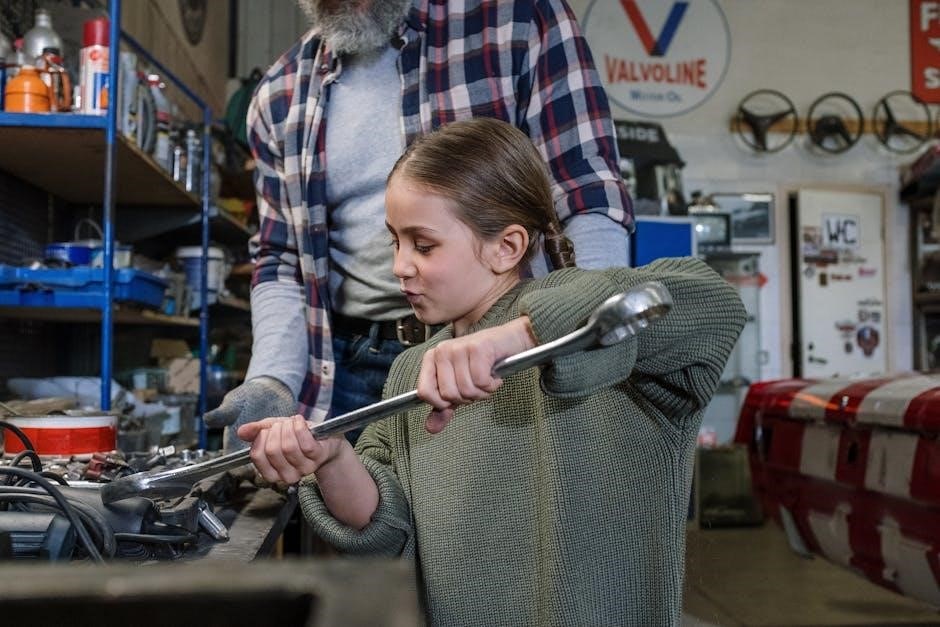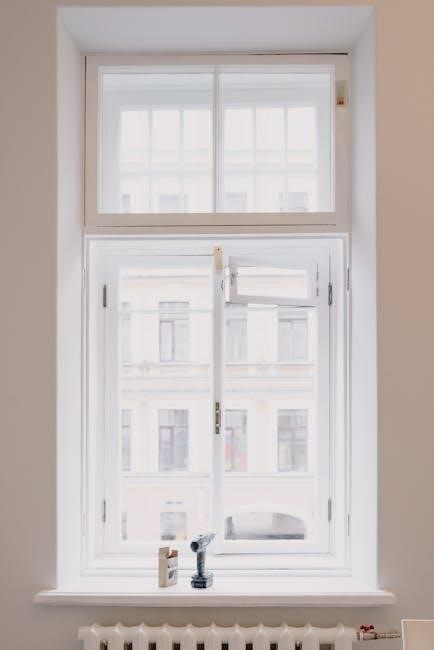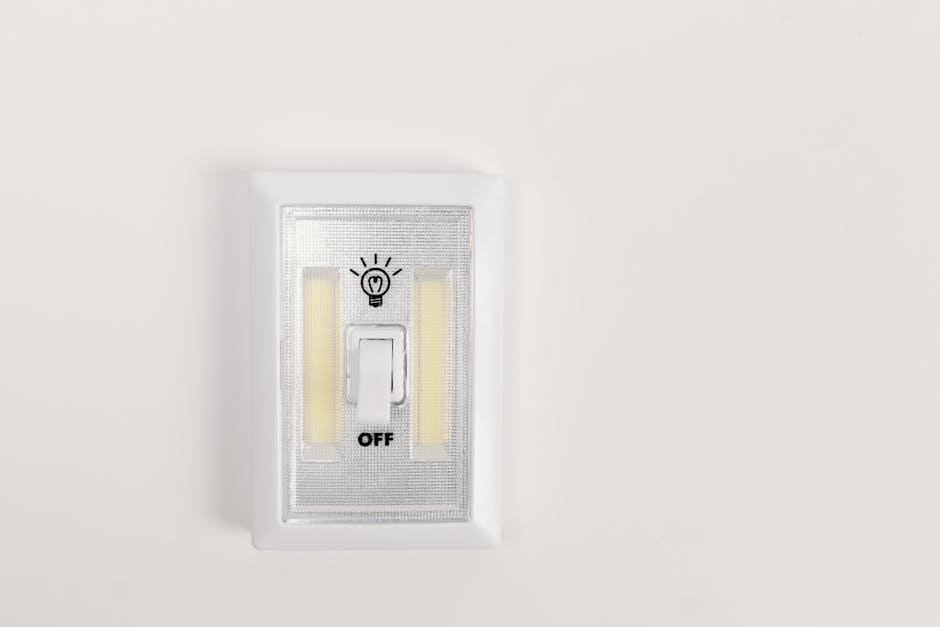A manual transfer switch is a critical device for safely switching between grid power and a generator. It ensures reliable power during outages‚ preventing dangerous backfeeding. Essential for home generators‚ it provides a secure‚ manual transition between power sources‚ safeguarding electrical systems and ensuring continuous power supply when needed.
1.1 What is a Manual Transfer Switch?
A manual transfer switch is a device that enables safe switching between grid power and a generator. It prevents dangerous backfeeding by manually disconnecting from the grid and connecting to the generator. This ensures a secure‚ controlled power transition‚ making it essential for home generator systems during outages.
1.2 Importance of a Manual Transfer Switch for Home Generators
A manual transfer switch is essential for safely connecting a generator to a home’s electrical system. It prevents dangerous backfeeding‚ protects appliances‚ and ensures reliable power during outages. This device is crucial for maintaining safety‚ avoiding electrical hazards‚ and providing a seamless transition between grid and generator power‚ making it a vital investment for homeowners.
Understanding the Cost Factors
Installation costs vary based on labor‚ materials‚ and location. Factors include the switch type‚ system complexity‚ and regional labor rates‚ affecting the total expense significantly.
2.1 Types of Manual Transfer Switches
Manual transfer switches vary by capacity and design‚ including single-phase and three-phase models. Portable options are compact and versatile‚ while whole-house switches offer comprehensive coverage for all circuits. The choice depends on the generator’s power output and the home’s electrical needs‚ impacting both upfront and installation costs significantly.
2.2 Capacity and Size of the Switch
The capacity of a manual transfer switch‚ measured in amps‚ directly impacts its cost. Larger switches with higher amp ratings‚ such as 200 amps‚ are more expensive. The physical size and number of circuits also influence the price‚ with bigger units requiring more materials and complex installations‚ increasing overall costs.
2.3 Brand and Quality of the Switch
Reputable brands like Generac and Reliance offer high-quality switches‚ increasing costs due to advanced features and durability. Premium materials and certifications‚ such as UL listing‚ justify higher prices. Budget-friendly options exist but may lack longevity and safety features‚ making brand and quality key factors in determining the switch’s cost and reliability.
Installation Costs
Installation costs include labor‚ materials‚ and permits. Electricians typically charge $500–$1‚500‚ depending on complexity and location. Total costs may vary based on system requirements and local regulations.
3.1 Labor Costs for Electricians
Labor costs for installing a manual transfer switch range from $300 to $1‚200‚ depending on the electrician’s expertise‚ location‚ and installation complexity. Urban areas typically have higher labor rates compared to rural regions‚ and experienced electricians may charge more for intricate systems.
3.2 Material and Equipment Costs
Material and equipment costs for a manual transfer switch installation typically range from $300 to $2‚000‚ depending on the switch’s capacity‚ type‚ and brand. Higher-end models with more circuits or advanced features cost more‚ while basic switches are more affordable. Additional materials like wiring and connectors may add to the total cost.
3.3 Permits and Inspections
Permits and inspections are necessary for a manual transfer switch installation‚ adding $50 to $500 to the total cost. These ensure compliance with local electrical codes and safety standards. Failing to obtain permits can result in fines. Hiring a licensed electrician helps navigate this process smoothly and avoid potential penalties.
Factors Influencing Total Cost
The total cost is influenced by the electrical system’s complexity‚ location accessibility‚ and local regulations. These factors determine labor‚ materials‚ and permitting requirements‚ affecting the final price.
4.1 Complexity of the Electrical System
The complexity of the electrical system significantly impacts installation costs. Systems with more circuits or higher power requirements need larger switches‚ increasing material expenses. Additionally‚ intricate wiring or existing panel configurations may require custom solutions‚ raising labor costs for electricians to ensure safe and proper connections.
4.2 Location and Accessibility
Location and accessibility influence installation costs. Remote or hard-to-reach areas may require additional travel fees for electricians. Difficult access to the electrical panel or generator location can increase labor time‚ raising overall expenses. Urban areas typically offer easier access‚ reducing costs compared to rural installations.
4.4 Local Electrical Codes and Regulations
Local electrical codes and regulations significantly affect installation costs. Compliance with specific requirements may necessitate additional materials or labor‚ increasing expenses. Permits and inspections mandated by local authorities also add to the total cost‚ ensuring safety and adherence to regional standards for generator and transfer switch setups.
Average Cost Estimates
Manual transfer switches cost between $300–$900 installed‚ depending on size‚ brand‚ and installation complexity. Larger or high-end models may exceed this range.
5.1 Manual Transfer Switch Unit Cost
The cost of a manual transfer switch unit typically ranges from $300 to $900‚ depending on the size and features. A basic 6-circuit switch may cost around $300‚ while a 10-circuit model can range up to $650. High-end models with advanced features may exceed $900.
5.2 Total Installation Cost Range
Installation costs for a manual transfer switch typically range from $600 to $1‚900. This includes the switch unit‚ labor‚ and materials. Basic setups with a 6-circuit switch may cost around $600‚ while complex systems with higher capacity or additional features can reach up to $1‚900.
5.3 Comparison with Automatic Transfer Switches
Manual transfer switches are generally more affordable than automatic ones‚ costing $300–$1‚500 compared to $900–$2‚500 for automatic switches. Manual switches require operator intervention‚ while automatic switches activate seamlessly during outages. Automatic switches offer greater convenience but at a higher cost‚ making manual switches a budget-friendly option for occasional generator use;

Scenario-Based Cost Analysis
Installation costs vary by setup: whole-house systems range from $1‚000 to $3‚000‚ essential circuits cost $500–$1‚500‚ and portable setups typically range from $300 to $900‚ depending on complexity and requirements.
6.1 Whole-House Transfer Switch Installation
Whole-house manual transfer switch installations typically cost between $1‚000 to $3‚000. This includes the switch‚ sub-panel‚ and labor. The setup allows all circuits to be powered by a generator‚ ensuring complete home coverage during outages‚ with costs varying based on system size‚ complexity‚ and local labor rates.
6.2 Essential Circuit Transfer Switch Installation
Installing a manual transfer switch for essential circuits typically costs $300 to $1‚000. This setup powers critical systems like lights‚ refrigeration‚ and HVAC. Labor costs are generally lower due to fewer circuits‚ making it a cost-effective solution for small homes or those prioritizing basic power needs during outages.
6.3 Portable Generator Transfer Switch Setup
Setting up a portable generator transfer switch typically costs between $200 and $500. This includes the switch and basic installation. It’s an affordable option for occasional use‚ ensuring safe connection of the generator to selected circuits without modifying the main electrical panel‚ ideal for temporary power solutions during outages.
DIY vs. Professional Installation
Installing a manual transfer switch can be DIY for experienced individuals‚ saving labor costs‚ but hiring a licensed electrician ensures safety‚ compliance‚ and proper functionality‚ especially for complex systems.
7.1 Pros and Cons of DIY Installation
DIY installation saves money but requires electrical expertise. It offers a sense of accomplishment but poses risks like safety hazards and potential electrical issues if improperly done. Experience is crucial for success.
7.2 Benefits of Hiring a Licensed Electrician
Hiring a licensed electrician ensures proper installation‚ adhering to safety standards and local codes. Their expertise minimizes risks of electrical hazards and guarantees a reliable setup. Additionally‚ it provides peace of mind and future-proofing‚ as professionals offer warranties and support for their work.
7.3 Risks of Improper Installation
Improper installation of a manual transfer switch can lead to dangerous electrical hazards‚ including shocks‚ fires‚ and equipment damage. It may also result in non-compliance with safety standards‚ voiding warranties‚ and increasing the risk of power outages. Such mistakes can compromise both safety and efficiency of the electrical system.

Regional Cost Variations
Installation costs vary by region due to labor rates‚ urban vs. rural locations‚ and local supplier pricing for manual transfer switches and related equipment.
8.1 Urban vs. Rural Installation Costs
Installation costs differ significantly between urban and rural areas. Urban areas often have higher labor rates due to demand‚ while rural areas may face higher material costs and accessibility challenges‚ impacting the total price for manual transfer switch installations.
8.2 Regional Labor Rate Differences
Regional labor rates significantly impact installation costs. Areas with higher cost of living or demand for electricians typically see elevated labor costs. Additionally‚ local regulations and union rates can influence pricing‚ leading to variability in labor charges for manual transfer switch installations across different regions.
8.3 Local Supplier Pricing for Switches
Local supplier pricing for manual transfer switches varies based on availability‚ brand‚ and quality. In urban areas‚ suppliers may offer competitive pricing due to higher demand‚ while rural areas could see higher costs due to limited options. Shopping around and comparing prices can help find the best deals for your needs.

Additional Costs
Additional costs may include sub-panel installations‚ generator compatibility adjustments‚ and future maintenance. These expenses ensure proper system integration and long-term reliability of your manual transfer switch setup.
9.1 Sub-Panel Installation
Installing a sub-panel is often necessary to manage circuits powered by the generator. This involves adding a secondary electrical panel‚ wiring‚ and connectors. Costs typically range between $300 to $800‚ depending on complexity and materials. A licensed electrician ensures safe and proper installation‚ integrating it seamlessly with the transfer switch system.
9.2 Generator Compatibility and Hookup
Ensuring your generator is compatible with the transfer switch is crucial for safe operation. Costs for hookup include wiring‚ connectors‚ and labor‚ typically ranging from $200 to $500. A licensed electrician ensures proper installation‚ matching the generator’s power rating and connection type‚ such as L14-30‚ for seamless functionality and safety.
9.4 Future Maintenance and Upgrades
Regular maintenance for a manual transfer switch ensures optimal performance and safety. Costs include annual inspections by a licensed electrician‚ typically ranging from $75 to $150. Upgrades‚ such as replacing contacts or adding circuits‚ may add $200 to $500‚ ensuring compatibility with future generator upgrades and maintaining reliability over time.
Budgeting Tips
Compare prices for switches and labor‚ negotiate with contractors‚ and plan for future upgrades to avoid extra costs later. Shop smart and allocate wisely.
10.1 Shopping for the Best Deals
Research online marketplaces like Amazon or Home Depot for competitive pricing. Check local electrical suppliers for discounts. Compare features‚ read reviews‚ and negotiate with contractors for bulk purchases or bundle deals. Ensure warranties are included‚ and consider offseason installations for potential savings. Avoid the cheapest options to maintain quality and safety standards.
10.2 Negotiating with Contractors
10.3 Planning for Future Expansion
Consider future electrical needs when selecting a manual transfer switch. Choose a modular system that allows for easy upgrades or additional circuits. Budget for potential expansions and consult with a licensed electrician to ensure scalability. Planning ahead can save costs and ensure your system adapts to growing energy demands efficiently.

Case Studies and Examples
A typical residential installation involved a 30-amp manual transfer switch for $500‚ including labor and materials‚ powering essential circuits during outages effectively.
11.1 Typical Residential Installation Example
A homeowner installed a 30-amp manual transfer switch for $500‚ covering labor and materials. It powered essential circuits‚ ensuring safety and reliability during outages. The switch connected to a portable generator‚ providing seamless power transitions and protecting the home’s electrical system from damage.
11.2 Small Business or Commercial Setup Example
A small business installed a 200-amp manual transfer switch‚ costing $2‚000 to $5‚000‚ including labor and materials. It powered essential systems like lighting‚ HVAC‚ and security‚ ensuring uninterrupted operations during outages. The setup required a licensed electrician to handle the complex wiring and higher capacity needs.
11.3 Budget-Friendly vs. High-End Installations
Budget-friendly installations focus on basic functionality‚ using manual transfer switches and essential materials‚ costing $500 to $2‚000. High-end setups include premium switches‚ advanced features‚ and durable components‚ ranging from $3‚000 to $10‚000. Budget options suit small needs‚ while high-end systems offer scalability and reliability for larger or critical applications.
Manual transfer switches are essential for safe generator hookups‚ with costs varying based on complexity‚ location‚ and quality. Proper installation ensures reliability and safety‚ making it a worthwhile investment for homeowners and businesses alike.
12.1 Recap of Key Cost Factors
The primary cost factors include the type of switch‚ its capacity‚ brand quality‚ installation complexity‚ location‚ and labor rates. Additional expenses involve materials‚ permits‚ and optional features like sub-panels. Budgeting should account for these elements to ensure a comprehensive and accurate financial plan for the installation project.
12.2 Final Tips for Homeowners
Research local electricians‚ compare quotes‚ and ensure compatibility with your generator. Plan for future power needs and consider ease of use. Always follow local codes and opt for durable‚ long-lasting switches. Check warranties and after-sales support for added peace of mind.



